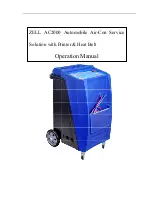
Using the Algorithms
Reverbs
5-3
Reverbs
Room Type
changes the conÞguration of the algorithm to simulate a wide array of room types
and sizes including booths, small rooms, chambers, halls and large spaces can be selected.
Because this parameter changes the structure of the reverb algorithm, you need to be careful
when assigning it an FXModÑchanging it in real time while signal is passing through it is
likely to cause audible artifacts. Room types in different Algorithms with similar names do not
necessarily sound the same.
Rvrb Time
is the RT
60
Ñthe time it takes for the reverb to decay to 60 dB below its initial levelÑ
in seconds. It is accurate assuming that several other parameters (HF Damping, Diff Scale, Size
Scale, and Density) are at their nominal levels. It is adjustable up to ÒInfÓ, which creates an
inÞnitely-sustaining reverb.
LateRvbTim
adjusts the basic decay time of the late portion of the reverb after diffusion.
L/R Pre Dly
(Pre-Delay) is the time between the start of a sound and the output of the Þrst
reverb reßections from that sound. Longer pre-delays can help make larger spaces sound more
realistic. Longer times can also help improve the clarity of a mix by separating the reverb signal
from the dry signal, so the dry signal is not obscured.
EarRef Lvl
adjusts the mix level of the early-reßection portion of Algorithms which offer early
reßections.
Late Lvl
adjusts the mix level of the late-reverb portion of Algorithms which offer early
reßections.
Diff Scale
scales the ÒdiffusionÒ of the early reßections, that is, how spread out they are as a
group over time. At very low settings, the early reßections start to sound quite discrete, and at
higher settings the early reßections are seamless. It is adjustable from 0.00 to 2.00, with 1.00
being nominal for the given Room Type.
Density
controls how tightly the early reßections are packed in time. Low Density settings
group the early reßections close together, while higher values spread the reßections for a
smoother reverb. It is adjustable from 0.00 to 4.00, with 1.00 being nominal (and usually
optimal) for the given Room Type.
Expanse
controls the amount of late reverb energy biased toward the edges of the stereo image.
A setting of 0% will bias energy towards the center. Moving away from 0% will bias energy
towards the sides. Positive and negative values will have a different character.
Build
adjusts the envelope of certain portions of the reverb. Positive values speed up the
envelope, and negative values slow it down.
Size Scale
changes the size of the current room. Altering this parameter will change the reverb
time and also cause some coloration of the reverb. It is adjustable from 0.00 to 4.00, with 1.00
being nominal (and usually optimal) for the given Room Type.
InÞnDecay
, when turned ÒOnÓ, causes the reverb tail to decay indeÞnitely. When itÕs ÒOffÓ, the
decay time is determined by the ÒRvrb TimeÓ or ÒLateRvbTimÓ parameters. This is a good
parameter to use under KDFX control with a footswitch.
Wet Bal
(Wet Balance). Some reverb Algorithms are actually two stereo reverbs in one, with
each one receiving a different mono signal. This balances the outputs of the two reverbsÑ0%
means they are being mixed equally.
Содержание KDFX
Страница 56: ...Inside KDFX Saving Studios and other objects 3 24...
Страница 76: ...Real time Control of KDFX KDFX in Auto Mode 4 20...
Страница 94: ...Using the Algorithms FXMod Diagnostic 5 18...
Страница 104: ...Special Topics Using the Internal Effects 6 10...
Страница 118: ...KDFX Objects KDFX Studios Appendix A 14...
Страница 154: ...KDFX Controller Assignments in Programs Setups Appendix B 36...
Страница 158: ...System Exclusive Control of KDFX Parameters Appendix C 4...
Страница 164: ...Index 6...















































